Decision-Making of Port Enterprise Safety Investment Based on System Dynamics
Abstract
1. Introduction
- To identify the risk factors influencing port safety operation.
- To develop a system dynamic model to explore the relationship between safety investment and system risk level.
- To verify the rationality and feasibility of the proposed model.
2. Interaction Analysis between the Risk and Safety Investment of Port Operation
Risk Factors Affecting the Port Operation Analysis
- Human factor
- 2.
- Equipment factor
- 3.
- Environment factor
- 4.
- Management factor
3. Decision-Making Model of Safety Investment on Port Operation Based on SD
- Step 1:
- Analyze the interaction between the port operation risk factors and safety investment represented by causal loop diagram of risk-safety investment among the four subsystems of human, equipment, environment, and management within each subsystem.
- Step 2:
- Explore the feedback mechanism among the factors.
- Step 3:
- Build the functional relationship among the factors based on the above analysis to complete the construction of SD model.
- Step 4:
- Conduct the sensitivity analysis to validate the model.
3.1. Interaction Analysis of Port Operation Risk and Safety Investment
- Loop (1): Safety awareness → risk level of human → risk level of the system → safety input → safety input for human risk → safety education and training → safety awareness.
- Loop (2): Skills and experience → risk level of human → risk level of the system → safety input → safety input for human risk → introduction of professionals → skills and experience.
- Loop (3): Physical and psychological states → risk level of human → system risk level → safety input → safety input for human risk → improvement of working environment → physical and psychological states.
- Loop (4): Risk level of management → risk level of the system → safety input → safety input for management risk → construction of safety culture → risk level of management.
- Loop (5): Risk level of management → risk level of the system → safety input → safety input for management risk → management level of outsourcing business → risk level of management.
- Loop (6): Risk level of management → risk level of the system → safety input → safety input for management risk → degree of information sharing → risk level of management.
- Loop (7): Risk level of management → risk level of the system → safety input → safety input for management risk → emergency management level → risk level of management.
- Loop (8): Risk level of facility → risk level of the system → safety input → safety input for facility risk → maintenance input → effectiveness of firefighting and monitoring equipment → risk level of facility.
- Loop (9): Risk level of facility → risk level of the system → safety input → safety input for facility risk → purchase input → effectiveness of production equipment → risk level of facility.
- Loop (10): Risk level of facility → risk level of the system → safety input → safety input for facility risk → purchase input → completeness of safety protection facilities → risk level of facility.
- Loop (11): Risk level of environment → risk level of the system → safety input → safety input for environment risk → navigation condition → risk level of environment.
3.2. Establishment of SD Model for Safety Investment and System Risk Level
3.3. Determination of Parameters and Functional Relations
3.3.1. Definition of Functional Relations of Variables
3.3.2. Determination of Parameters
- Initial value of level variables
- 2.
- Initial value of safety investment
- 3.
- Corresponding weight of each criteria
- Step 1:
- Construct a hierarchy structure (Figure 1).
- Step 2:
- Build a comparison matrix Aij based on the judgement of experts (see Table 2). The relative importance scale between two criteria as suggested by Saaty [28] is the most widely used. Attributing values that vary from 1 to 9, the scale determines the relative importance of one criterion when compared with another criterion.
- Step 3:
- Normalization, calculation of λmax, and consistency test CI and CR.
- Step 4:
- Weight calculation.
- 4.
- Initial value of conversion rate
4. Demonstration
- The idea of modelling is based on the current risk level of the system under the given condition, introducing the input of risk management and control to explore the interaction between the economic input and risk level of the system.
- The effects of scenarios analysis to the risk level of system are based on the view of safety investment. Any investment could be in a form of economic input, which means using economic input to quantify the input of risk management and control.
- The initial values of all variables are from the investigation and questionnaire towards the two groups—academic/researcher group and the port operator group. In order to express the interaction between the variables, corresponding weights were introduced.
4.1. Model Test
4.2. Simulation and Analysis
4.3. Contrastive Analysis of Adjustment Schemes
- Adjustment of total safety investment
- 2.
- Adjustment of safety investment for subsystem
- 3.
- Adjustment of the conversion rate
5. Conclusions
- Risk factors influencing the port safety operation were identified from human, facility and equipment, management, and environment by in-depth interviews with experienced practitioners and researchers interested in port operation and management, and by referring to the ideas and theories in some related document, which was the basis of exploring the relationship between the influencing factors. H1 was confirmed, systemically identifying the risk factors relating to port safety operation from a systematic perspective.
- A risk management and control model of port safety operation was built with SD based on the causal diagram of influencing factors established. By observing the development tendency and evolution process of risk level in the port operation, it revealed the feedback mechanism between the risk level of port operation system and safety input. H2 was confirmed, establishing that the causal diagram between investment on the risk factors and system risk level is easy to understand and modelling the risks in port safety operation.
- By sensitivity analysis, it was revealed that investment on the human subsystem can cause the risk level to decrease rapidly and produce the best effect, followed by the management subsystem, while adjusting the safety investment for subsystem, safety input distribution ratio, and improving the conversion rate. Specifically, the safety investment should be expanded in human and management, especially in safety education and training and safety culture construction, which could contribute more to the reduction of risk level of the port operation. H3 was confirmed, i.e., investment on human and management subsystems could make the system risk level decrease rapidly and produce the better effects than the other two subsystems.
- The SD method is implemented to simulate the safety investment strategy of port enterprises, and the information feedback mechanism between the safety investment and the level of system risk is clarified. It can provide a new methodology for port enterprises to carry out risk management and decision-making. However, safety in production is dynamic in port operation. Even if the same investment policy may have different effects, this depends on the effectiveness of implementation. Hence, how to make use of safety investment is still an issue that needs to be discussed further.
Author Contributions
Funding
Conflicts of Interest
References
- Mabrouki, C.; Bentaleb, F.; Mousrij, A. A decision support methodology for risk management within a port terminal. Saf. Sci. 2014, 63, 124–132. [Google Scholar] [CrossRef]
- Alises, A.; Molina, R.; Gómez, R.; Pery, P.; Castillo, C. Overtopping hazards to port activities: Application of a new methodology to risk management (Port Risk Management Tool). Reliab. Eng. Syst. Saf. 2014, 123, 8–20. [Google Scholar] [CrossRef]
- Alyami, H.; Yang, Z.; Riahi, R.; Bonsall, S.; Wang, J. Advanced uncertainty modelling for container port risk analysis. Accid. Anal. Prev. 2019, 123, 411–421. [Google Scholar] [CrossRef]
- John, A.; Paraskevadakis, D.; Bury, A.; Yang, Z.; Riahi, R.; Wang, J. An integrated fuzzy risk assessment for seaport operations. Saf. Sci. 2014, 68, 180–194. [Google Scholar] [CrossRef]
- Ozbas, B. Safety Risk Analysis of Maritime Transportation: Review of the Literature. Transp. Res. Rec. 2013, 2326, 32–38. [Google Scholar] [CrossRef]
- Yip, T.L. Port traffic risks—A study of accidents in Hong Kong waters. Transp. Res. Part E Logist. Transp. Rev. 2008, 44, 921–931. [Google Scholar] [CrossRef]
- Wachter, J.K.; Yorio, P.L. A system of safety management practices and worker engagement for reducing and preventing accidents: An empirical and theoretical investigation. Accid. Anal. Prev. 2014, 68, 117–130. [Google Scholar] [CrossRef]
- Fabiano, B.; Currò, F.; Reverberi, A.P.; Pastorino, R. Port safety and the container revolution: A statistical study on human factor and occupational accidents over the long period. Saf. Sci. 2010, 48, 980–990. [Google Scholar] [CrossRef]
- Hou, Z.; Zhao, P. Structure Optimization of Safety Investment of Petrochemical Port Enterprises. Math. Probl. Eng. 2017, 2017, 1–5. [Google Scholar] [CrossRef]
- Yang, Z.; Ng, A.K.Y.; Lee, P.T.-W.; Wang, T.; Qu, Z.; Sanchez Rodrigues, V.; Lau, Y.-Y. Risk and cost evaluation of port adaptation measures to climate change impacts. Transp. Res. Part D Transp. Environ. 2018, 61, 444–458. [Google Scholar] [CrossRef]
- Kwesi-Buor, J.; Menachof, D.A.; Talas, R. Scenario analysis and disaster preparedness for port and maritime logistics risk management. Accid. Anal. Prev. 2019, 123, 433–447. [Google Scholar] [CrossRef] [PubMed]
- Li, C.; Ren, J.; Wang, H. A system dynamics simulation model of chemical supply chain transportation risk management systems. Comput. Chem. Eng. 2016, 89, 71–83. [Google Scholar] [CrossRef]
- Richardson, G.P. Reflections on the foundations of system dynamics. Syst. Dyn. Rev. 2011, 27, 219–243. [Google Scholar] [CrossRef]
- Liu, P.; Liu, C.; Du, J.; Mu, D. A system dynamics model for emissions projection of hinterland transportation. J. Clean. Prod. 2019, 218, 591–600. [Google Scholar] [CrossRef]
- Torres, J.P.; Kunc, M.; O’Brien, F. Supporting strategy using system dynamics. Eur. J. Oper. Res. 2017, 260, 1081–1094. [Google Scholar] [CrossRef]
- International Shipping Federation. Safety Culture Is Enlightened Self- Interest; Maritime International Secretariat Services Ltd.: London, UK, 2011. [Google Scholar]
- International Maritime Organization. MSC77/17—Role of the Human Element; IMO: London, UK, 2003. [Google Scholar]
- Corrigan, S.; Kay, A.; Ryan, M.; Ward, M.E.; Brazil, B. Human factors and safety culture: Challenges and opportunities for the port environment. Saf. Sci. 2019, 119, 252–265. [Google Scholar] [CrossRef]
- Berg, H.P. Human Factors and Safety Culture in Maritime Safety (revised). Trans. Nav. Int. J. Mar. Navig. Saf. Sea Transp. 2013, 7, 343–352. [Google Scholar] [CrossRef]
- Weick, K.E.; Sutcliffe, K.M. Managing the Unexpected: Assuring High Performance in an Age of Complexity; JosseyBass, a John Wiley & Sons. Inc. Company: San Francisco, CA, USA, 2001. [Google Scholar] [CrossRef]
- Rusconi, C. Interactive Training, a Methodology for Improving Safety Culture. In Proceedings of the International Experts’ Meeting on Human and Organizational Factors in Nuclear Safety in the Light of the Accident at the Fukushima Daiichi Nuclear Power Plant, Vienna, Austria, 21–24 May 2013. [Google Scholar]
- Darbra, R.M.; Crawford, J.F.E.; Haley, C.W.; Morrison, R.J. Safety culture and hazard risk perception of Australian and New Zealand maritime pilots. Mar. Policy 2007, 31, 736–745. [Google Scholar] [CrossRef]
- Zheng, Z.Y.; Huang, Z.G.; Wu, Z.L. Relationship Analysis of Port Traffic Accidents and Port Environment Factors. J. Traffic Transp. Eng. 2006, 1. [Google Scholar] [CrossRef]
- Gordon, R.; Kirwan, B.; Perrin, E. Measuring safety culture in a research and development centre: A comparison of two methods in the Air Traffic Management domain. Saf. Sci. 2007, 45, 669–695. [Google Scholar] [CrossRef]
- Bauk, S.; Schmeink, A.; Colomer, J. An RFID model for improving workers’ safety at the seaport in transitional environment. Transport 2018, 33, 353–363. [Google Scholar] [CrossRef]
- Bauk, S.; Schmeink, A.; Colomer, J. Employing wireless networks in enhancing occupational safety at the developing seaport–two proposals. Pol. Marit. Res. 2017, 24, 115–124. [Google Scholar] [CrossRef]
- Lertpattarapong, C. Applying System Dynamics Approach to the Supply Chain Management Problems. Master’s Thesis, Massachusetts Institute of Technology, Cambridge, MA, USA, 2002. [Google Scholar]
- Saaty, T.L. Decision making with the analytic hierarchy process. Int. J. Serv. Sci. 2008, 1, 83–98. [Google Scholar] [CrossRef]
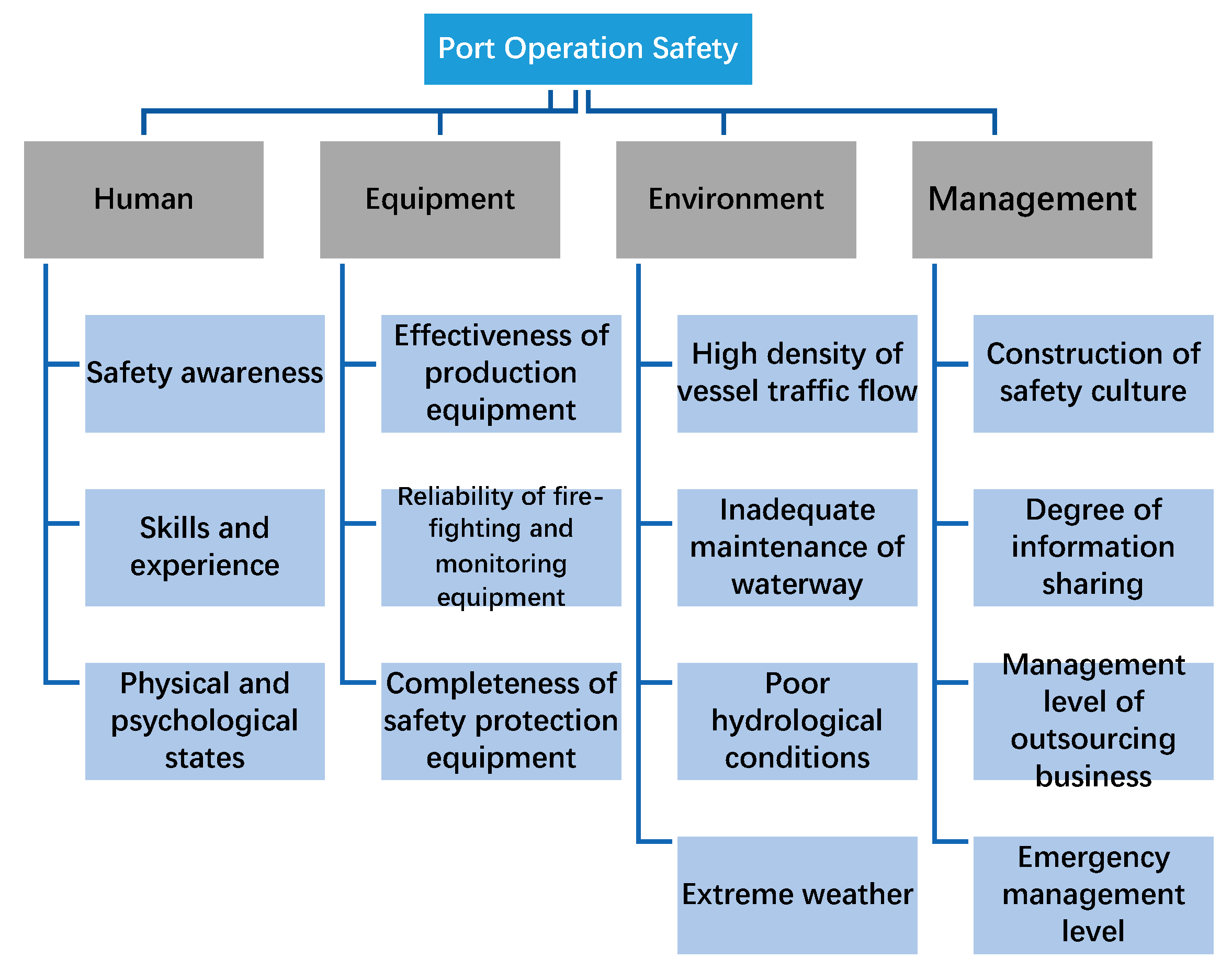
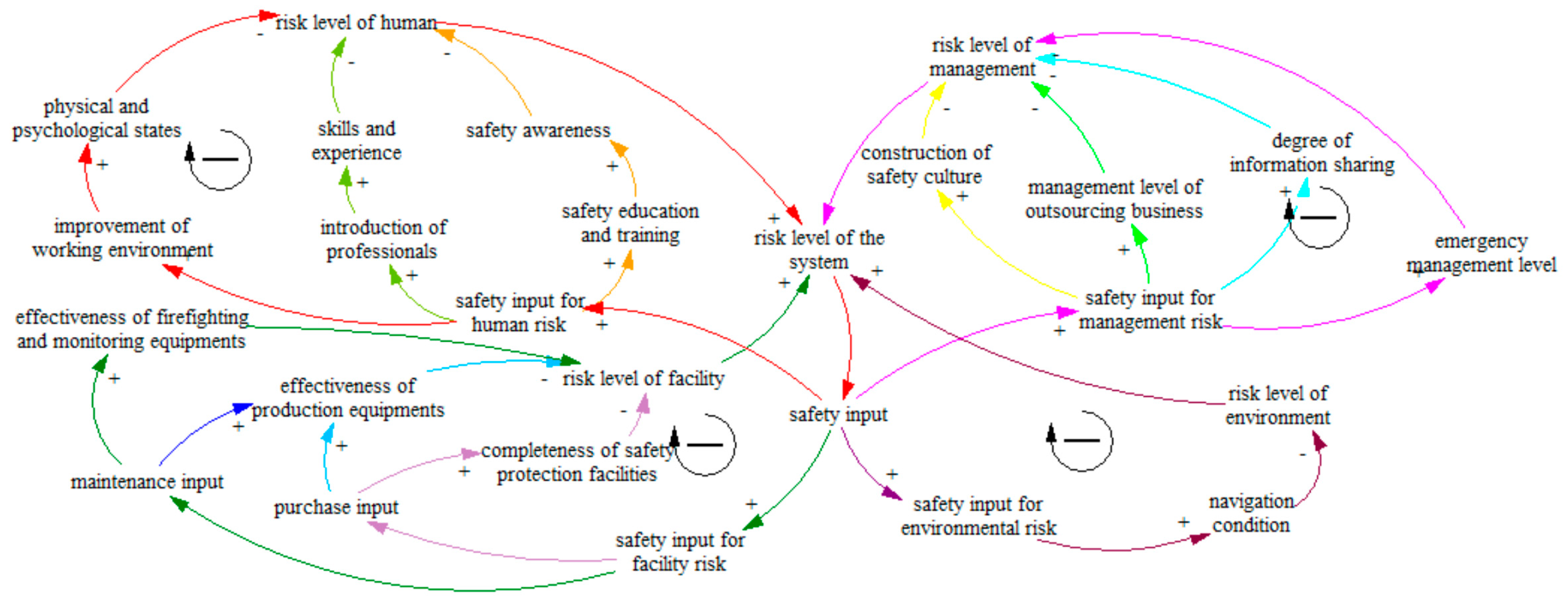
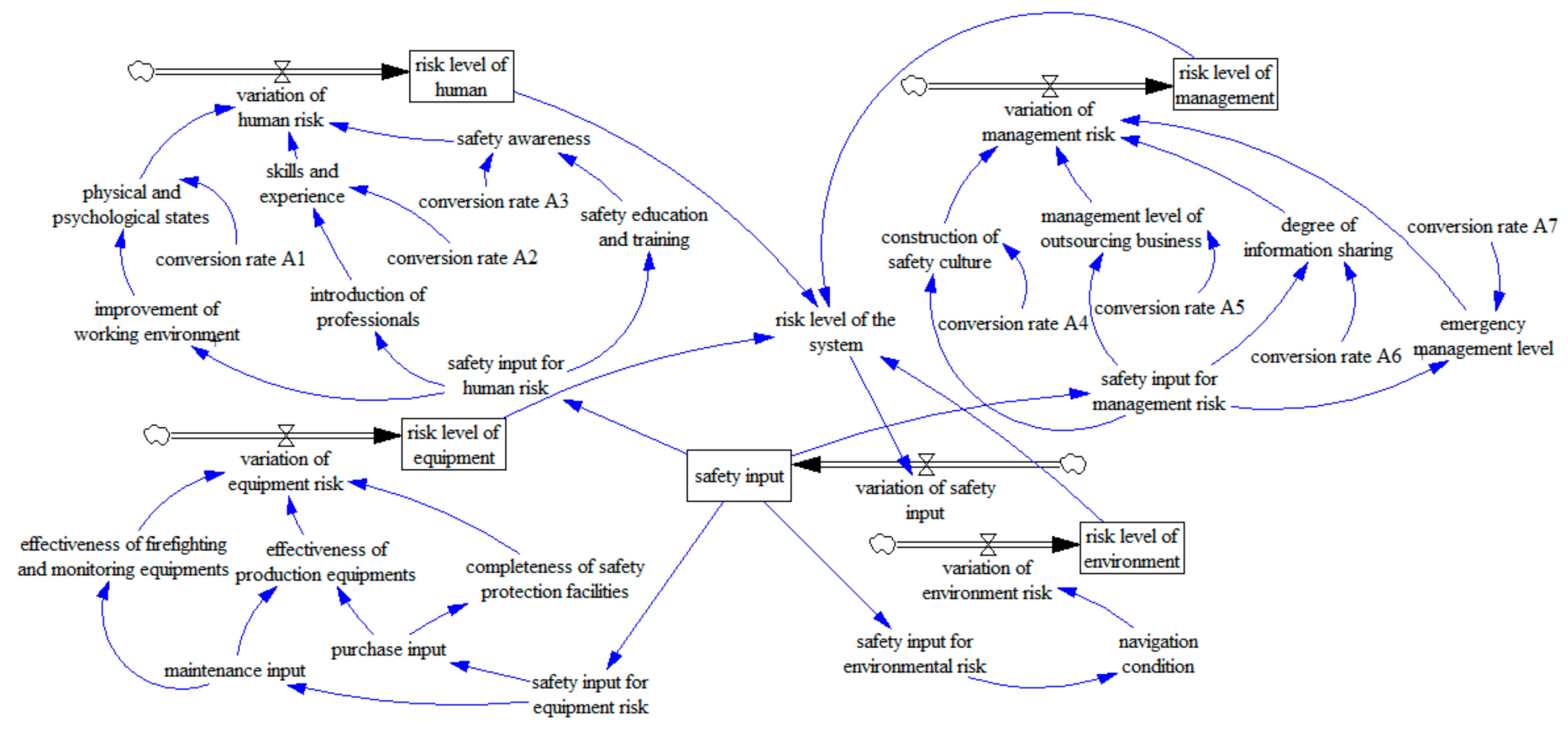
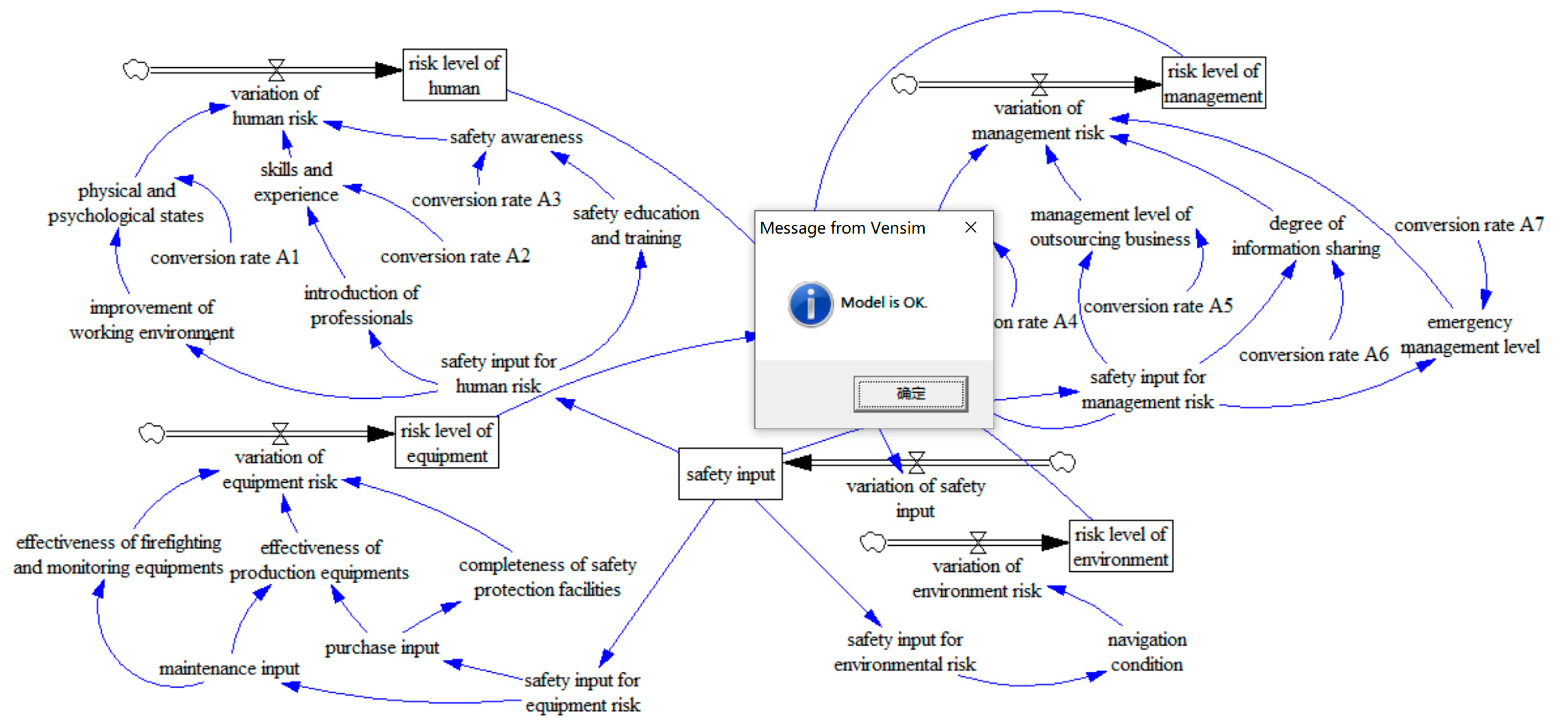

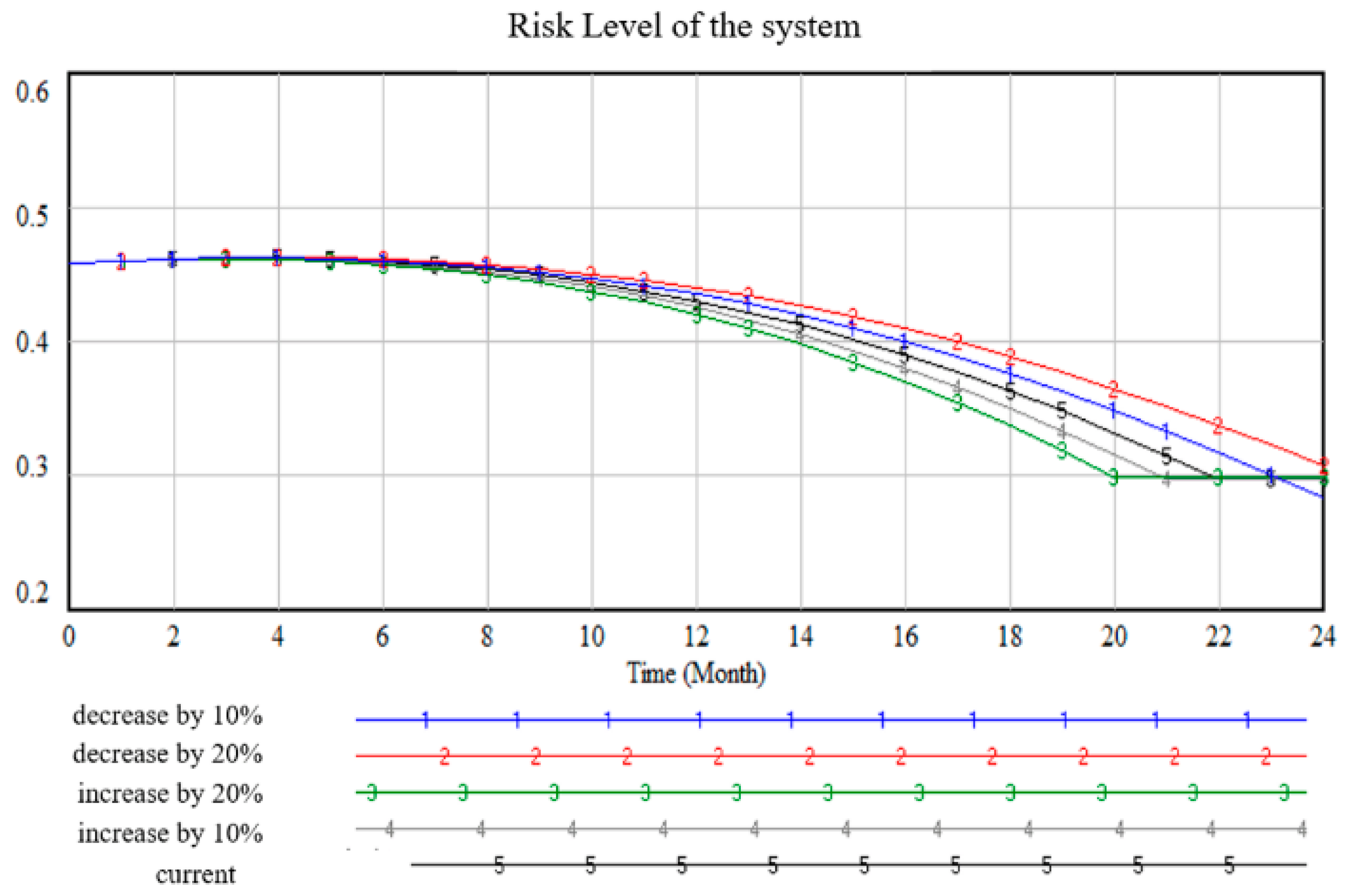
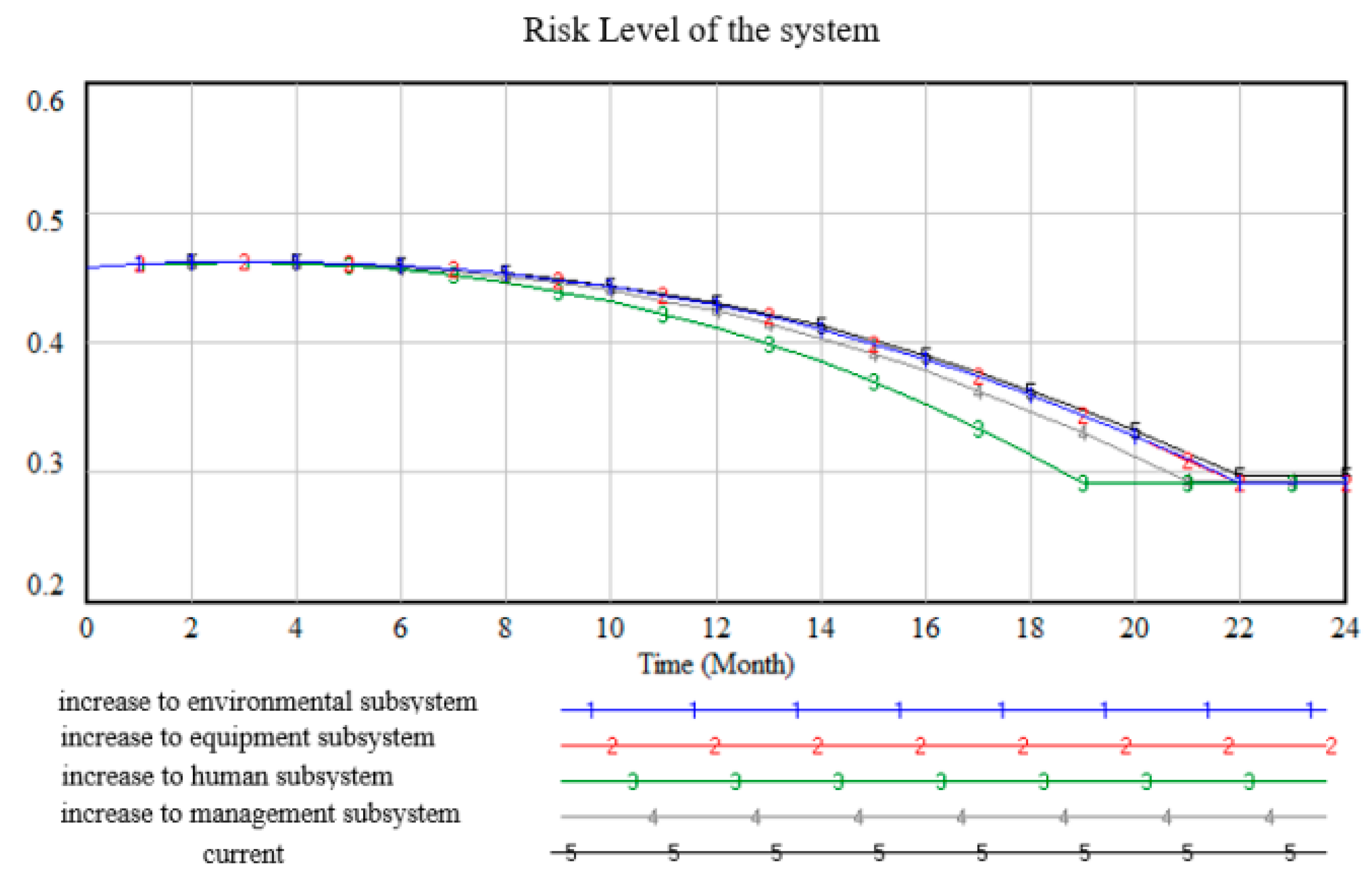
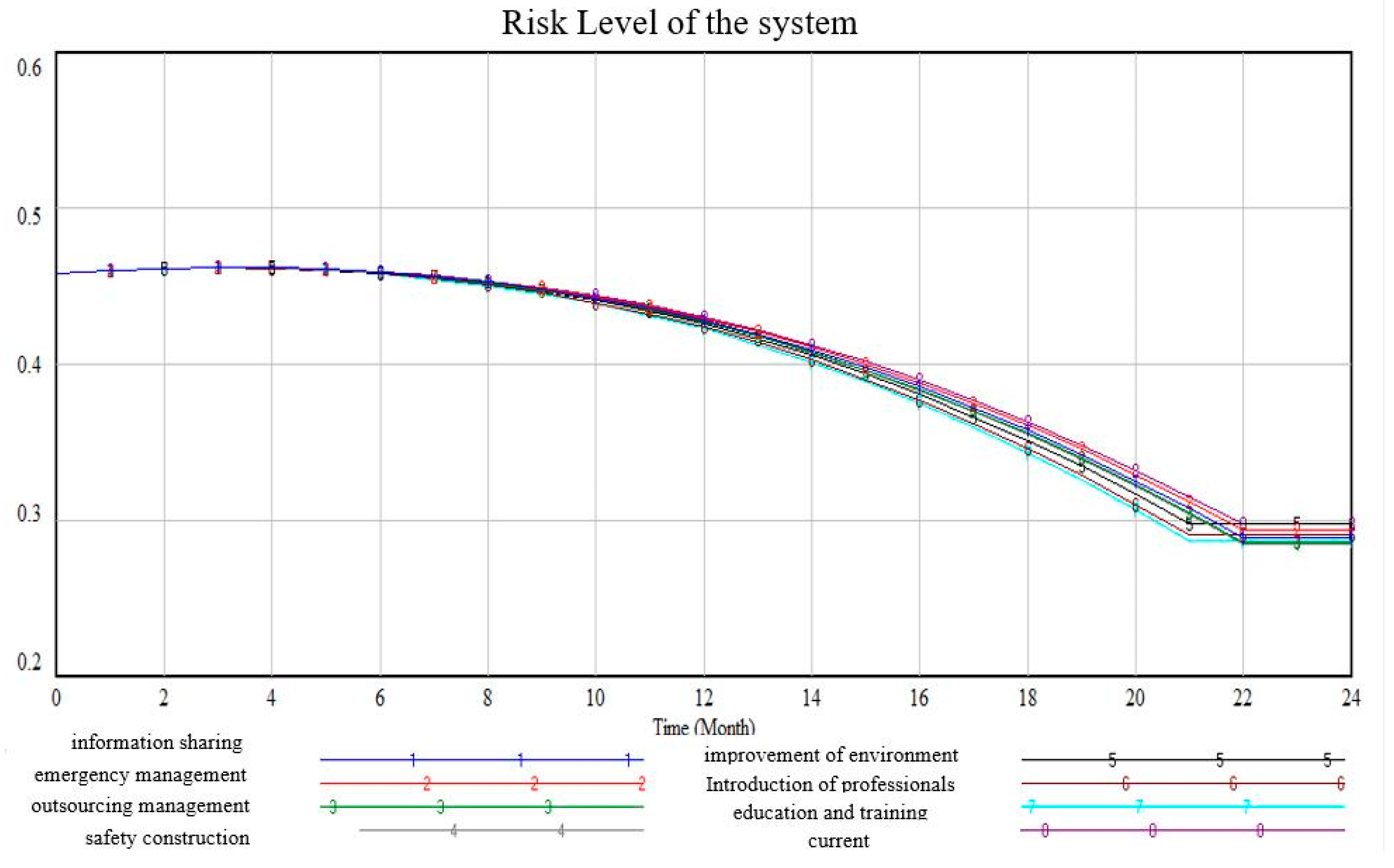
| Variable | Function |
|---|---|
| safety input | INTEG (variation of safety input, initial value) |
| variation of safety input | IF THEN ELSE (risk level of the system > target safety level, monthly input,0) |
| risk level of the system | human risk level × QZ1 + management risk level × QZ2+equipment risk level × QZ3+environmental risk level × QZ4 |
| risk level of human | INTEG (variation of human risk level, initial value) |
| variation of human risk level | Safety awareness × QZ5 + skills and experience × QZ6 + physical and psychological states × QZ7 |
| safety awareness | safety education and training × conversion rate A3 |
| skills and experience | introduction of professionals × conversion rate A2 |
| physical and psychological states | improvement of working environment × conversion rate A1 |
| risk level of equipment | INTEG (variation of equipment risk level, initial value) |
| variation of equipment risk level | effectiveness of production equipment × QZ8 + reliability of fire-fighting and monitoring equipment × QZ9 + completeness of safety protection facilities × QZ10 |
| effectiveness of production equipment | SMOOTHI (investment in maintenance × QZ11 + investments in purchase × QZ12,1,0) |
| reliability of firefighting and monitoring equipment | SMOOTHI (investment in maintenance × QZ13,1,0) |
| completeness of safety protection facilities | SMOOTHI (investments in purchase × QZ14,1,0) |
| risk level of management | INTEG (variation of management risk level, initial value) |
| variation of management risk level | construction of safety culture × QZ15 + management level of outsourcing business × QZ16 + degree of information sharing × QZ17 + emergency management level × QZ18 |
| construction of safety culture | Safety input for management risk◊QZ15◊conversion rate A4 |
| management level of outsourcing business | Safety input for management risk◊QZ16◊conversion rate A5 |
| degree of information sharing | Safety input for management risk◊QZ17◊conversion rate A6 |
| emergency management level | Safety input for management risk◊QZ18◊conversion rate A7 |
| risk level of environment | INTEG(variation of environment risk level, initial value) |
| Aij | Human | Equipment | Management | Environment |
|---|---|---|---|---|
| Human | 1 | 2 | 4 | 6 |
| Equipment | 1/4 | 1 | 1/3 | 3/2 |
| Management | 1/2 | 3 | 1 | 5 |
| Environment | 1/6 | 1/5 | 2/3 | 1 |
| Factors | Variables | Corresponding Weight |
|---|---|---|
| Human (0.486) | Safety awareness | 0.407 |
| Skills and experience | 0.357 | |
| Physical and psychological states | 0.236 | |
| Equipment (0.115) | Effectiveness of production equipment | 0.411 |
| Reliability of firefighting and monitoring equipment | 0.306 | |
| Completeness of safety protection equipment | 0.283 | |
| Management (0.320) | Construction of safety culture | 0.334 |
| Degree of information sharing | 0.243 | |
| Management level of outsourcing business | 0.316 | |
| Emergency management level | 0.107 | |
| Environment (0.078) | Maintenance of waterway | 1 |
© 2020 by the authors. Licensee MDPI, Basel, Switzerland. This article is an open access article distributed under the terms and conditions of the Creative Commons Attribution (CC BY) license (http://creativecommons.org/licenses/by/4.0/).
Share and Cite
Sun, J.; Wang, H.; Chen, J. Decision-Making of Port Enterprise Safety Investment Based on System Dynamics. Processes 2020, 8, 1235. https://doi.org/10.3390/pr8101235
Sun J, Wang H, Chen J. Decision-Making of Port Enterprise Safety Investment Based on System Dynamics. Processes. 2020; 8(10):1235. https://doi.org/10.3390/pr8101235
Chicago/Turabian StyleSun, Jiachen, Haiyan Wang, and Jie Chen. 2020. "Decision-Making of Port Enterprise Safety Investment Based on System Dynamics" Processes 8, no. 10: 1235. https://doi.org/10.3390/pr8101235
APA StyleSun, J., Wang, H., & Chen, J. (2020). Decision-Making of Port Enterprise Safety Investment Based on System Dynamics. Processes, 8(10), 1235. https://doi.org/10.3390/pr8101235




